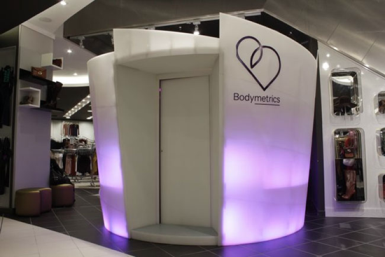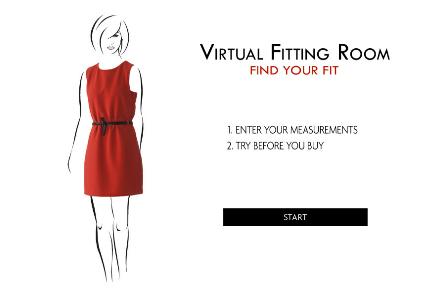Web anthropometry: yesterday, today, tomorrow
 Who likes to go shopping for clothes? Sweating in the dressing rooms, shifting in underwear in anticipation: "but let's try this one again"? Even the girls, unfairly accused of adoring turning around in front of a mirror (they are trying for us for this), after two hours of transitions from the dressing room to the dressing room, they lose heart.
Who likes to go shopping for clothes? Sweating in the dressing rooms, shifting in underwear in anticipation: "but let's try this one again"? Even the girls, unfairly accused of adoring turning around in front of a mirror (they are trying for us for this), after two hours of transitions from the dressing room to the dressing room, they lose heart. As always, when people do not want to do anything, robots are used.
2D fitting rooms will not surprise anyone

The ideas that lead the genealogy from the props of street photographers with a hole for sticking their heads in differ in variations of the overlay objects: mannequin, image of clothes, your own photo.

How such things work, you can see, for example, at: SHOWROOMS.ru - “a unique service with the ability to try on and reserve things in Moscow stores with a discount of up to 30% right on the site”. OnlineDress is a "media portal and social network about fashion." Such a fitting looks funny, but no funnier than creepy mannequins in fashion boutiques. I don’t know about you, but on these services I like the buttons “Remove all” most of all.
Virtualization, of course, is minimal. As one acquaintance of the major used to say, “automation is at the level: the button is pressed - the bag is on the back”.
Kinect does not steer
With the advent of Kinect, the virtual fitting room toy in offline clothing stores is becoming fashionable.

The same 2D product model is superimposed on the image of the buyer. It’s hard to say how much the store is benefiting from. Unless - the entertainment of visitors; for example, you can have fun trying on clothes that are clearly not intended for you.

Bloomingdales Bodymetrics scanner has some prospects, in terms of application in online technologies. The three-dimensional human model obtained in such a scanner can theoretically be used in online stores. But, one wonders what to do for those who are not available for scanning? And those whose conditions change with age or even season? And why complicate it so much if everyone always has the good old cloth "meter" on hand?
However, Kinect features attract supporters. For example, the Forbes startup contest semi-finalist talks about the technical secrets of his online scanner fitting room .
Estonian fitting room
Anthropometric seriously destroy the barrier in the online fashion retailer took in Fits.me .

The team, consisting of specialists from the Laboratory of Intelligent Materials and Systems of the University of Tartu, the Robotics Center of Tallinn University of Technology and Human Solutions GmbH, the “leading provider of anthropometric data”, has developed its own version of the virtual fitting room. According to four anthropometric dimensions (height, neck, waist and wrists), the system sets up a three-dimensional model, on which things are measured in online stores. The fitting room claims to create opportunities for increasing the share of e-commerce in the clothing category, which, according to their data, is 7% (or $ 31 billion in the US alone), while the share of computers or books sold online exceeds 50%.
Almost what you need
OptiTex , a serious CAD developer, has come close to solving the global anthropometry problem.

Why the service did not capture “all the Internet” can only be explained by the fact that the company wants to sell its software to designers and clothing designers. Well, a range of interests: from games to the aviation industry - can also serve as an explanation.
Many designers are fighting for the location of designers for clothing design programs. I have not studied this market specifically, but discovered examplesThe choice of computer-aided clothing design systems indicates that no CAD system will ever capture the entire market. But online stores and manufacturers do not care what kind of CAD clothes are designed in. The former would like to reduce the number of returns, and the latter would know how many models to put into production.
Future service
It remains to take one step to create a global anthropometric service.
Built similarly to the OptiTex model, it should be able to "read" the image of the model from all CAD formats used in the fashion industry. The client module must be distributed absolutely free. The only thing the service will take money for is the summary data for all Internet sites, and the manufacturer’s fee will be more than symbolic in comparison with the costs of over- or underproduction.
The central part of the service should allow anyone who wants to receive his (husband, wife, children, neighbor, mistress, etc.) copy for going to online stores. The level of identification here should be minimal. The maximum is the email address for sending the model code - in case the user does not want to write the code manually. Identification is required in the online store, but on which model the buyer tried on clothes, no one is interested except the buyer himself.
The service database will receive data (excluding service data) in the format: | model code | product code | store code | when the user performs an action involving the model in the online store.
A global success in this area expects a service that will allow designers and clothing designers to upload their virtual works on the Internet before they begin to produce them. On the other hand, customers will be able to try on new items on their virtual mannequins and express interest - depending on the service they use: buy, order, mark interest, set a price.
As a result of a simple game, the manufacturer will be able to get clear answers to the questions: whether to start production of the product, how much to produce, through which channels to distribute, etc.
And those who can launch the web anthropometry service can answer these questions. IMHO, abruptly Fasebook should turn out.
